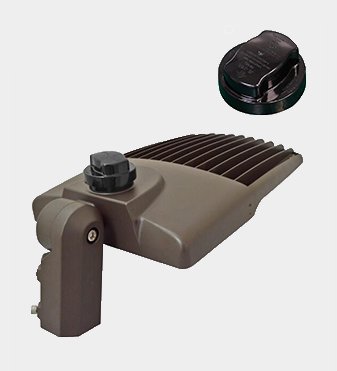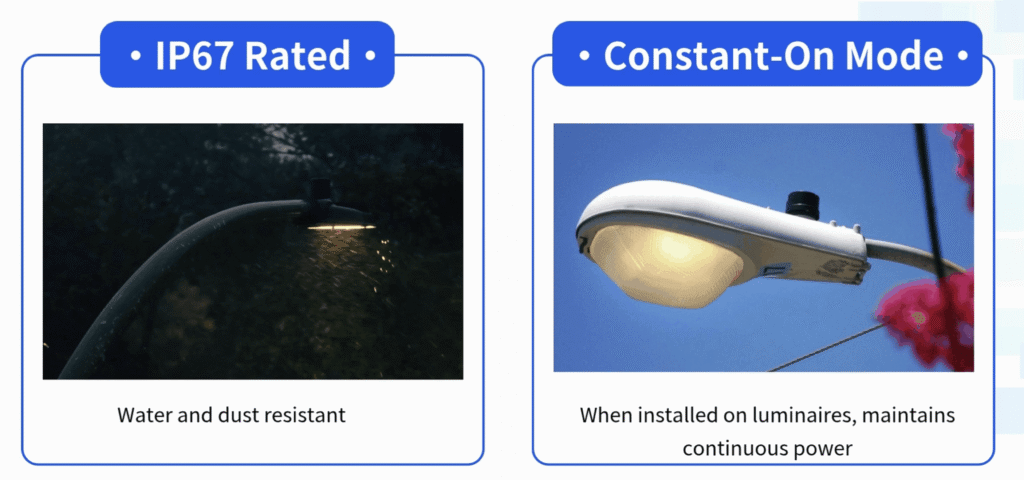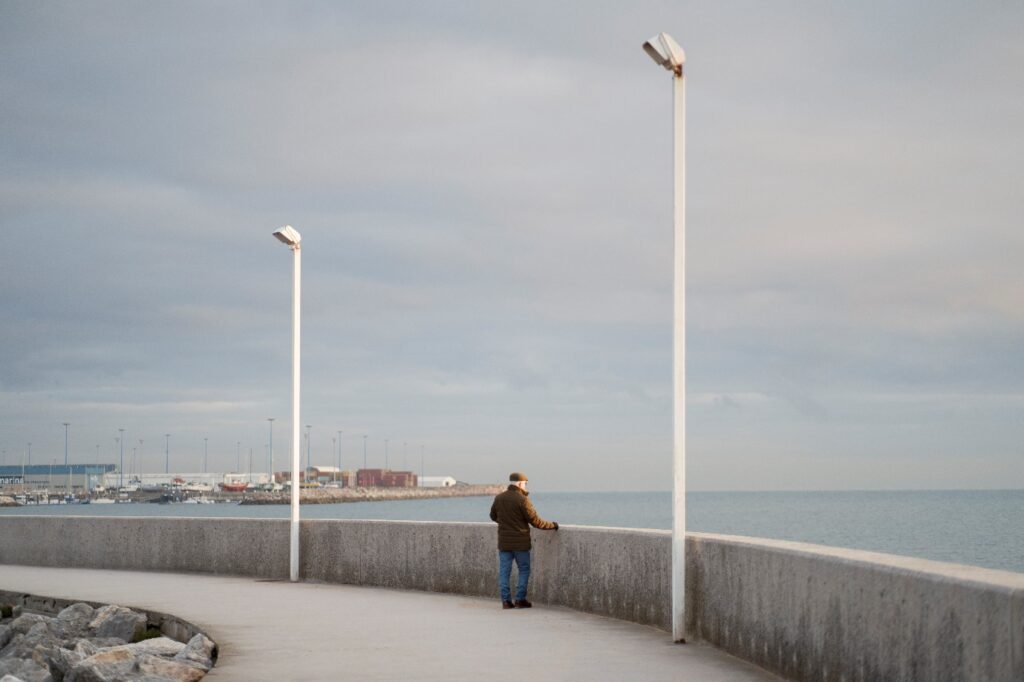Introduction: Clearing the Misunderstanding
In outdoor lighting projects, photocells and shorting caps are mostly discussed in the same context. Some project managers and even technicians mistakenly think that they are competing devices, one designed for automatic dusk-to-dawn control and the other to bypass that control. In reality, the two components are made to balance one another instead of competing.
A photocell is a sensor-driven solution that gives long-term energy efficiency and smart functionality to outdoor lighting systems. A shorting cap, is a simple connector that ensures constant power to a luminaire when a photocell is unavailable, undergoing maintenance, or yet to be installed. This makes shorting caps a critical streetlight maintenance accessory and not a rival product.
Understanding this difference is vital for municipalities and manufacturers who want to boost lighting efficiency and get rid of unnecessary downtime.
What Does a Photocell Do?
Photocells, mostly called dusk-to-dawn sensors, are the basis of modern streetlight control. Their primary role is to detect ambient light levels and automate the switching of luminaires.
Key Functions of Photocells
- Automatic dusk-to-dawn control
Photocells identify surrounding light, and turn lights on and off at dusk and dawn, this mechanization avoids human error and make sure that lights operate consistently with natural cycles.
- Eficiencia energética
By getting rid of unnecessary operations during the day, photocells save energy. Fewer operational hours extend the lifespan of LED modules and drivers, making them a valuable energy-efficient lighting tool.
- Smart city integration
Modern photocells are not limited to simple ON/OFF switching. Many advanced models are part of smart lighting sensors, offering dimming, lux threshold programming, IoT connectivity, and real-time monitoring.

What Is a Shorting Cap?
A shorting cap is a straightforward but powerful device. It is installed in the same receptacle as a photocell, typically a NEMA socket, but instead of sensing light, it creates a direct electrical connection to keep the luminaire in a constant ON mode.
Key Features of Shorting Caps
- Protección impermeable IP67
Make sure of durability against dust, rain, and temporary water immersion. - Normas ANSI C136.10 compatibility
Guarantees that shorting caps fit securely into standard NEMA twist-lock sockets. - Continuous power mode
No sensing functionality, lights stay on as long as power is supplied.



While a célula fotoeléctrica manages lighting intelligently, a shorting cap makes sure of uninterrupted illumination when photocells are not present or functional. This is why it’s often described as a photocell replacement tool during specific project stages.
How Shorting Caps Support Photocells
The relationship between the two devices becomes clearer when we explore situations where shorting caps are indispensable. They don’t replace photocells but instead step in as temporary backups or testing tools.
Temporary Replacement During Faults
If a photocell fails, waiting for a replacement could leave areas dangerously dark. Installing a shorting cap keeps the luminaire powered, maintaining safety until the photocell is swapped.
Adjustment or Commissioning Stage
During initial installation or calibration, technicians often prefer lights to remain continuously on. Shorting caps simplify testing, verifying wiring connections, and checking system stability before introducing automated control.
Waiting for Photocell Upgrades
Large projects sometimes roll out in phases. While advanced dusk-to-dawn lighting backup systems may be installed later, shorting caps provide immediate illumination during interim periods.
Factory Testing Before Shipment
Manufacturers frequently use shorting caps to test luminaires before delivery. Continuous operation ensures quality inspection without needing to install or program photocells at the factory stage.
How Shorting Caps Support Photocells
| Guión | Role of Shorting Cap | Beneficio |
| Photocell failure | Temporary replacement | Prevents unsafe dark spots |
| Commissioning & calibration | Keeps luminaire ON during setup | Simplifies wiring and diagnostics |
| Project phase rollout | Maintains illumination until photocell upgrade | Avoids gaps in lighting coverage |
| Factory testing | Provides constant power | Ensures product reliability before shipment |
Why They Are Complementary, Not Opposing
The idea of shorting cap vs photocell is misleading. They aren’t competitors but partners that fulfill different roles in outdoor lighting systems.
- Photocells = automation and long-term efficiency
They give smart dusk-to-dawn control, energy savings, and IoT integration. - Shorting caps = continuity and reliability
They step in during maintenance or equipment replacement, making sure that lights remain powered when photocells are unavailable.
When used together, they form a balance in automation and reliability. This is why experienced engineers never view them as replacement but as complementary devices that ensure outdoor lighting controls always function seamlessly.
Best Practices for Using Shorting Caps and Photocells Together
To get the most out of both devices, municipalities and contractors should follow a few simple guidelines:
- Treat shorting caps as temporary solutions
They are not meant for long-term installations because they cannot save energy.
- Use them during critical scenarios
Commissioning, repairs, and testing are the best times to deploy shorting caps.
- Restore photocells as soon as possible
Automated dusk-to-dawn control should be reintroduced fast to reduce wasted energy.
- Check for ANSI C136.10 compliance
Both photocells and shorting caps must act in accordance with this standard to confirm interchangeability and safety.
By following these, project teams can balance reliability with energy efficiency. Shorting caps should always be viewed as supportive tools, not permanent solutions. Combining them wisely with photocells ensures uninterrupted lighting, faster maintenance, and long-term compliance with modern outdoor lighting controls and smart city standards.
Conclusion: A Partnership for Reliable Street Lighting
In the discussion of shorting cap vs photocell, the reality is clear, they are not rivals. Each plays a distinct but complementary role in outdoor lighting networks. Photocells bring automation, energy savings, and dusk-to-dawn efficiency, while shorting caps confirms reliability during downtime, commissioning, or system testing.
For municipalities, contractors, and manufacturers, recognizing this partnership helps maintain reliable, safe, and efficient streetlight systems. Both devices are crucial streetlight maintenance accessories, ensuring that outdoor lighting is never compromised by technical or environmental challenges.
En Eléctrico con tapa de plomo, we supply:
- ANSI-compliant shorting caps for reliable, temporary operation.
- Advanced photocells with IoT and dimming features.
- Expert guidance to help cities balance efficiency with reliability.
Ready to optimize your outdoor lighting system? Contact Lead-Top today for certified photocell replacement tools and high-quality shorting caps that keep your projects running smoothly.
Referencias:
- https://leaditop.com/
- https://en.wikipedia.org/wiki/National_Electrical_Manufacturers_Association
- https://en.wikipedia.org/wiki/Internet_of_things
- https://en.wikipedia.org/wiki/American_National_Standards_Institute
- https://leaditop.com/product-category/product/shorting-cap/
- https://leaditop.com/product-2/







